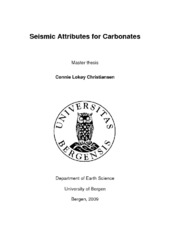Seismic Attributes for Carbonates
Master thesis
Permanent lenke
https://hdl.handle.net/1956/7169Utgivelsesdato
2009-06-02Metadata
Vis full innførselSamlinger
- Department of Earth Science [1033]
Sammendrag
Seismic attributes can reveal important information about rock properties, and rock physics modeling provide a link between geological and seismic parameters. Carbonate rocks can have wide variations in properties due to their origin and susceptibility to post-depositional diagenetic processes. Thus, quantification of factors influencing seismic properties is important for seismic inversion. Porosity, pore shapes, depth and pressure, mineralogy, and fluid saturation are important factors affecting carbonate rock properties. Rock physics modeling can be used as a tool to study the seismic effects of such factors. By exploring seismic velocities and amplitude versus offset (AVO) responses, in addition to utilizing rock physics templates (RTP) as an analytical tool, trends for different rock property factors have been observed for a synthetic carbonate model. Porosity and pore-shapes is observed to have a major importance for effective seismic responses, while mineralogy is less determent. Due to the fact that rocks with different properties may have similar seismic velocities, or comparable AVO responses, differentiation and quantification of various property-affecting factors is essential for inversion purposes. Comparison of responses viewed by different analytical methods enhances such differentiation and quantification. The importance of evaluating AVO responses in accordance with background trend is demonstrated, and AVO analysis can serve as an important method for fluid detection.
